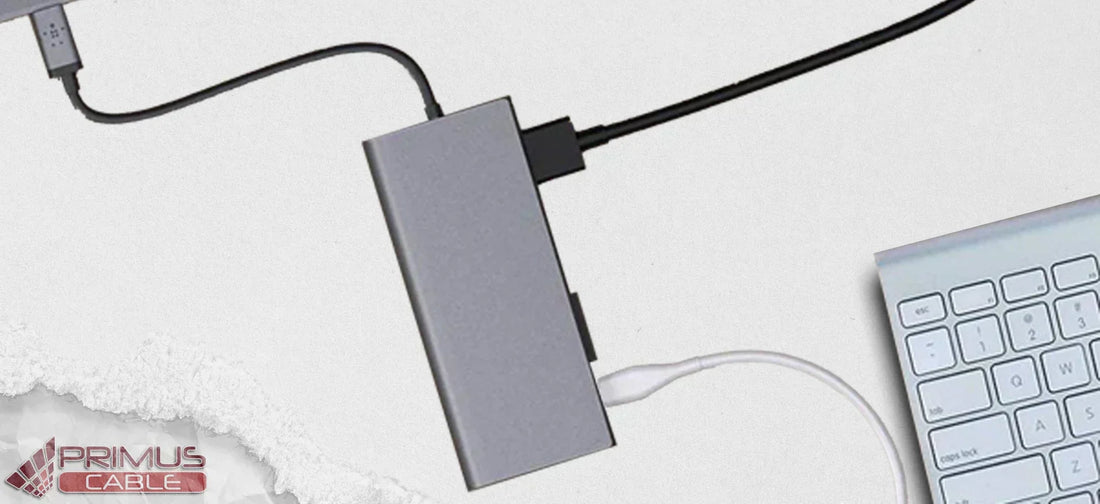
The Essential Guide to USB Cables
Understanding Modern USB Standards
USB technology has evolved from simple peripheral connections to a comprehensive ecosystem supporting data transfer, video output, and power delivery. The latest USB4 standard offers speeds up to 40Gbps, while USB Power Delivery can now handle up to 240W - enough to power high-performance laptops.
Key USB Types and Their Uses:
|
USB Type |
Max Speed |
Power Delivery |
Common Uses |
|
USB-A 2.0 |
480Mbps |
2.5W |
Keyboard, mice, old devices |
|
USB-A 3.0 |
5Gbps |
4.5W |
External HDDs, flash drives |
|
USB-C 3.2 |
20Gbps |
100W |
Modern laptops, 4K displays |
|
USB4 |
40Gbps |
240W |
High-end workstations |

USB Power Fundamentals Demystified
Understanding USB power delivery is crucial for optimizing device performance and preventing connectivity issues. Modern USB implementations have transformed from simple data cables into sophisticated power delivery systems capable of charging everything from earbuds to workstations.
Power Delivery Specifications:
|
Standard |
Voltage |
Max Current |
Max Power |
Charging Capability |
|
USB 2.0 |
5V |
500mA |
2.5W |
Basic Peripherals |
|
USB 3.0 |
5V |
900mA |
4.5W |
Smartphones |
|
USB BC 1.2 |
5V |
1.5A |
7.5W |
Fast charging |
|
USB-C PD |
5-48V |
5A |
240W |
Laptops, Monitors |
Key Power Considerations:
- Voltage Negotiation: USB-C PD devices communicate to determine optimal voltage (5V, 9V, 15V, 20V, etc.)
- Cable Quality Matters: Only certified cables support full power delivery
- Port Limitations: Many computers limit per-port output regardless of cable capability
- Multi-Port Dynamics: Total power is often shared across multiple ports on hubs and laptops
Real-World Power Scenarios:
- Charging a smartphone while transferring data requires stable 7.5W+ delivery
- External SSDs need consistent power to prevent disconnections during transfers
- Docking stations must balance power between ports and attached displays
- High-performance laptops may throttle if not receiving full PD specification power
Optimizing Your USB Setup
Proper USB configuration begins with understanding your power requirements and data transfer needs. A well-planned setup prevents the most common connectivity headaches.
Setup Recommendations:
- Prioritize Power: Allocate high-wattage ports to demanding devices first
- Quality Cables: Invest in certified cables matching your highest-power device
- Port Mapping: Note which ports share power budgets on your computer
- Hub Strategy: Use self-powered hubs for high-demand peripherals
- Future-Proofing: Consider USB4/Thunderbolt for upcoming devices
Solving USB Connection Challenges
Many users experience USB recognition problems, often related to power delivery or cable quality. These issues frequently lead users to reconsider their entire USB setup strategy - which is where understanding proper hub selection becomes crucial.
Troubleshooting Checklist:
- Try different USB ports (some may provide more power)
- Check for physical damage to cables/connectors
- Update USB drivers through Device Manager
- Test with a different, high-quality cable
- For persistent issues, a powered hub often provides the solution
Selecting the Ideal USB Hub
When standard USB ports can't meet your connectivity needs, a quality hub bridges the gap. The right hub choice depends on understanding your specific requirements for speed, power, and device compatibility.
Advanced Hub Features Worth Considering:
- Individual port switches: Enable power management per device
- LED indicators: Show connection and power status
- Mixed port types: Combine USB-A and USB-C for versatility
- Ethernet passthrough: Add wired network connectivity
- SD card readers: Built-in media slots for photographers
For demanding setups like video editing stations or financial trading desks, look for hubs with:
- Overcurrent protection: Prevents damage from power surges
- Heat dissipation: Aluminum housings or cooling fans
- Cable strain relief: Reinforced connections for heavy use
- VESA mount compatibility: Clean desk mounting options
Common USB Questions Answered
Why won't my computer recognize my USB device?
This could indicate insufficient power, driver issues, or cable problems. Try connecting to different ports with a known-good cable before troubleshooting further.
What's the maximum USB cable length?
For reliable operation:
- USB 2.0: 5 meters
- USB 3.0: 3 meters
- USB4/Thunderbolt: 2 meters (active cables can extend further)
Can USB cables affect charging speed?
Absolutely. Poor quality cables may not support fast charging protocols. Look for cables certified for USB-IF standards matching your devices.
How do I connect USB-C to older displays?
Quality adapters can convert USB-C to HDMI, VGA, or DisplayPort while maintaining signal integrity. For 4K resolution, ensure the adapter supports HDMI 2.0 or DisplayPort 1.4.
Final Recommendations
For reliable performance across all your USB connections:
- Use certified cables from reputable manufacturers
- Organize cables to prevent strain on connectors
- Consider a powered hub for multiple high-demand devices
- Regularly check for driver/firmware updates
- Label cables by type/speed for easy identification
The transition from troubleshooting to selecting the right hub equipment creates a natural progression in solving connectivity challenges. Whether addressing immediate recognition issues or planning an expansive workstation setup, understanding these USB fundamentals ensures compatible, high-performance connections across all your devices.

